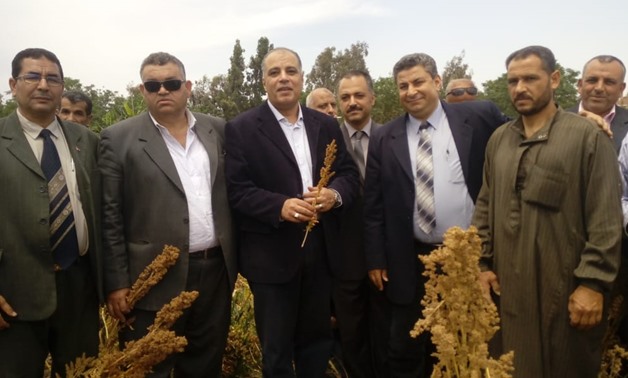
The Ministry of Agriculture launched a national campaign to expand the cultivation of quinoa, April 27, 2018 – Egypt Today
CAIRO – 28 April 2018: Having the potential to aid food security in the 21st century in the context of climate change, a national campaign to expand the cultivation of quinoa, a natural food resource of high nutritive value, has been launched by the Ministry of Agriculture.
The quinoa grain can be roasted and then made to flour in order to make different types of breads and pastas. It also can be added to soups or used as a cereal.
The underutilized grain is found to be high in protein, zinc and calcium, and thus can be used in the baby food industries.
Quinoa reduces dependence on other staples like wheat and rice
The quinoa seed is one of the alternatives that the Ministry of Agriculture has set to reduce dependence on other staples like wheat and rice.
Quinoa is a water-conscious crop, as it needs much less water to cultivate than rice and wheat. While rice, on average, requires 6,000 cubic meters of water per feddan (1 feddan = 1.038 acres), quinoa only needs less than 500 cubic meters.
Lately, Minister of Irrigation and Water Resources Mohamed Abdel-Ati decided to reduce the agriculture area of rice in Egypt from 1.7 million feddans to 724,200 feddans. According to the ministry, this decline will save three billion cubic meters of water.

Moreover, quinoa is incredibly resilient and can grow in poor or salty soils, and it also has the ability to be grown well in very harsh circumstances, unlike most grains.
Egypt is the world’s largest wheat importer; the country imports half of the wheat consumed annually. Quinoa would serve to reduce the country’s wheat imports.
Quinoa health benefits
Quinoa is highly nutritious, gluten-free and packed with essential amino acids, fiber, vitamins and minerals.
For celiac patients, quinoa also stands as an alternative to wheat, as it is proven to be gluten-free.
It also scores lower than other crops on the glycemic index, a measure of how quickly foods raise blood sugar levels, and thus it can be used for diabetics.
 Quinoa cultivation, high economic return
Quinoa cultivation, high economic return
Minister of Agriculture Abd El-Moneim El Banna asserted that expanding the cultivation of quinoa will provide job opportunities for youth, especially in new industrial-agricultural areas and new reclamation zones.
According to the Agricultural Research Center (ARC), the average yield of quinoa grown in salty soil is reported to be 1 ton per feddan. The studies also revealed that quinoa is a cost-efficient and promising crop for the domestic grain market’s demands. It is also expected to be a valued crop for export, providing the state another means to bring more hard currency into the country.
Quinoa cultivation areas
Quinoa was first introduced in Egypt in 2005, being first cultivated in Nubie’ City, South Sinai to test its response to the harsh weather conditions; the crop showed exceptional adaptability to the well-drained soils.
Mahmoud Madani, head of the Agricultural Research Center, has said that the cultivated area of quinoa has reached more than 80 feddans in the period since 2010, being grown in 20 governorates, including South Sinai and Alexandria.





Comments
Leave a Comment